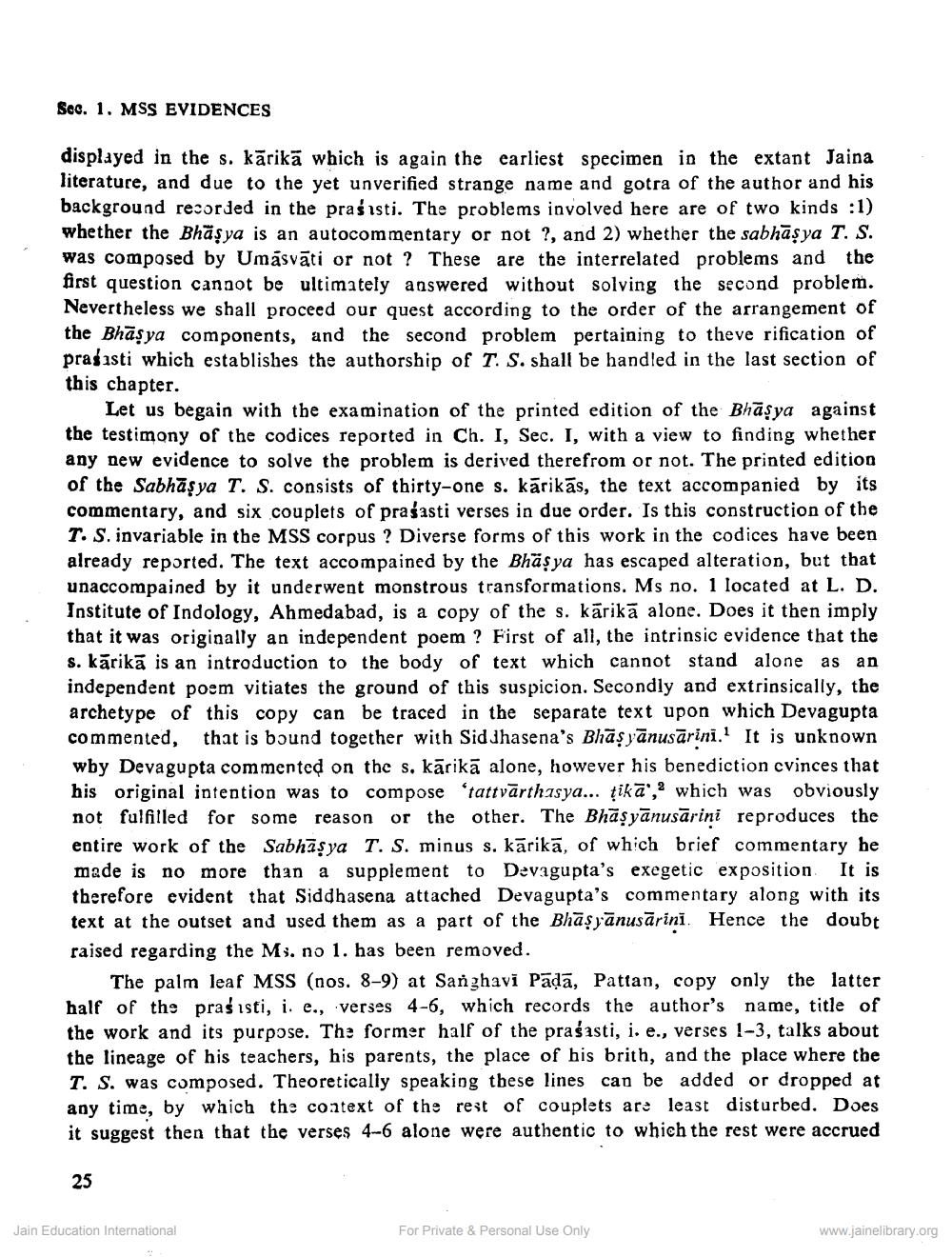________________
Sec. 1. MSS EVIDENCES
displayed in the s. karika which is again the earliest specimen in the extant Jaina literature, and due to the yet unverified strange name and gotra of the author and his background recorded in the prasasti. The problems involved here are of two kinds :1) whether the Bhasya is an autocommentary or not ?, and 2) whether the sabhāṣya T. S. was composed by Umásvati or not? These are the interrelated problems and the first question cannot be ultimately answered without solving the second problem. Nevertheless we shall proceed our quest according to the order of the arrangement of the Bhasya components, and the second problem pertaining to theve rification of prasisti which establishes the authorship of T. S. shall be handled in the last section of this chapter.
Let us begain with the examination of the printed edition of the Bhasya against the testimony of the codices reported in Ch. I, Sec. I, with a view to finding whether any new evidence to solve the problem is derived therefrom or not. The printed edition of the Sabhasya T. S. consists of thirty-one s. karikas, the text accompanied by its commentary, and six couplets of prasasti verses in due order. Is this construction of the T. S. invariable in the MSS corpus ? Diverse forms of this work in the codices have been already reported. The text accompained by the Bhasya has escaped alteration, but that unaccompained by it underwent monstrous transformations. Ms no. 1 located at L. D. Institute of Indology, Ahmedabad, is a copy of the s. karika alone. Does it then imply that it was originally an independent poem? First of all, the intrinsic evidence that the s. kārikā is an introduction to the body of text which cannot stand alone as an independent poem vitiates the ground of this suspicion. Secondly and extrinsically, the archetype of this copy can be traced in the separate text upon which Devagupta commented, that is bound together with Siddhasena's Blaşyanusarini. It is unknown. why Devagupta commented on the s. kärikä alone, however his benediction evinces that his original intention was to compose 'tattvärthasya... ikā, which was obviously not fulfilled for some reason or the other. The Bhāṣyanusarini reproduces the entire work of the Sabhasya T. S. minus s. karika, of which brief commentary he made is no more than a supplement to Devagupta's exegetic exposition. therefore evident that Siddhasena attached Devagupta's commentary along with its text at the outset and used them as a part of the Bhāṣyanusarini. Hence the doubt raised regarding the Ms. no 1. has been removed.
The palm leaf MSS (nos. 8-9) at Sanghavi Pādā, Pattan, copy only the latter half of the prasisti, i. e., verses 4-6, which records the author's name, title of the work and its purpose. The former half of the prasasti, i. e., verses 1-3, talks about the lineage of his teachers, his parents, the place of his brith, and the place where the T. S. was composed. Theoretically speaking these lines can be added or dropped at any time, by which the context of the rest of couplets are least disturbed. Does it suggest then that the verses 4-6 alone were authentic to which the rest were accrued
25
Jain Education International
For Private & Personal Use Only
www.jainelibrary.org




